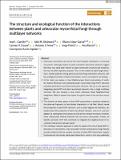Por favor, use este identificador para citar o enlazar a este item:
http://hdl.handle.net/10261/330493COMPARTIR / EXPORTAR:
 SHARE SHARE
 CORE
BASE CORE
BASE
|
|
| Visualizar otros formatos: MARC | Dublin Core | RDF | ORE | MODS | METS | DIDL | DATACITE | |

| Título: | The structure and ecological function of the interactions between plants and arbuscular mycorrhizal fungi through multilayer networks |
Autor: | Garrido Sánchez, José Luis; Alcántara, Julio M.; López-García, A.; Ozuna, Carmen CSIC ORCID; Perea, Antonio J. CSIC ORCID; Prieto Rubio, Jorge CSIC ORCID ; Rincón, Ana CSIC ORCID ; Azcón González de Aguilar, Concepción CSIC ORCID | Palabras clave: | Arbuscular mycorrhizal fungi Ecological function Interaction networks Multilayer networks Mutualistic interactions Plant community Plant recruitment |
Fecha de publicación: | 2023 | Editor: | John Wiley & Sons | Citación: | Functional Ecology 37:2217–2230 (2023) | Resumen: | Arbuscular mycorrhizas are one of the most frequent mutualisms in terrestrial ecosystems. Although studies on plant mutualistic interaction networks suggest that they may leave their imprint on plant community structure and dynamics, this has not been explicitly assessed. Thus, in the context of plant-fungi interactions, studies explicitly linking plant-mycorrhizal fungi interaction networks with key ecological functions of plant communities, such as recruitment, are lacking. In this study, we analyse, in two Mediterranean forest communities of southern Iberian Peninsula, how plant-arbuscular mycorrhizal fungi (AMF) networks modulate plant-plant recruitment interaction networks. We use a new approach integrating plant-AMF and plant recruitment networks into a single multilayer structure. We also develop a new metric (Interlayer Node Neighbourhood Integration, INNI) to explore the impact of a given node on the structure across layers. The similarity of plant species in their AMF communities is positively related to the observed frequency of recruitment interactions in the field. Results reveal that properties of plant-AMF networks, such as plant degree and centrality, can explain about the properties of plant recruitment network, such as in- and out-degree (i.e. sapling bank and canopy service) and its modular structure. However, these relationships differed between the two forest communities. Finally, we identify particular AMF that contribute to integrate the neighbourhood of recruitment interactions between plants. This multilayer network approach is useful to explore the role of plant-AMF interactions on recruitment, a key ecosystem function enhanced by fungi. Results provide evidence that the complex structure of plant-AMF interactions impacts functional and structurally plant-plant interactions, which in turn may potentially influence plant community dynamics, through their effects on the structure of the recruitment network. | Versión del editor: | http://dx.doi.org/10.1111/1365-2435.14378 | URI: | http://hdl.handle.net/10261/330493 | DOI: | 10.1111/1365-2435.14378 | Identificadores: | doi: 10.1111/1365-2435.14378 issn: 1365-2435 |
| Aparece en las colecciones: | (EEZ) Artículos (ICA) Artículos (CIDE) Artículos |
Ficheros en este ítem:
| Fichero | Descripción | Tamaño | Formato | |
|---|---|---|---|---|
| 2023_Garrido_FE_OA.pdf | 2,85 MB | Adobe PDF |  Visualizar/Abrir |
CORE Recommender
Page view(s)
56
checked on 29-abr-2024
Download(s)
27
checked on 29-abr-2024
Google ScholarTM
Check
Altmetric
Altmetric
Este item está licenciado bajo una Licencia Creative Commons

